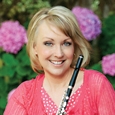When should students begin playing piccolo?
Piccolo playing should begin when a student has control of the sound, dynamics, and intonation in all three registers of the flute. Students should think of the piccolo’s tone as an extension of the flute’s upper register. The piccolo’s low register corresponds to the flute’s middle register, and the middle to the top octave of the flute. The top octave, however, is specific to the piccolo.
Contrary to common thought, piccolo playing does not ruin a flute embouchure, but strengthens it because the flutist learns to control the size of the aperture (opening in lips). The aperture for piccolo playing is smaller than for flute playing. A piccolo embouchure is a miniature version of a flute embouchure with a greater emphasis on forward direction. Think of blowing a kiss to someone across the room to create this forward feeling.
Breath control is also a little different on the piccolo. Since the piccolo is half the length of a flute, less air is used to play it well. The best advice for a flutist learning to play piccolo is to think of increasing the support and speed of the air, not using more air.
Should a middle school band director assign only one flutist to play all the piccolo parts?
Ideally it is best for a director to rotate piccolo parts between the strongest players so they all get experience playing both flute and piccolo. Sometimes this is difficult because the school owns only one piccolo. In this case, rotate the piccolo assignment by concert. Before assigning a flutist to play piccolo, a director should take the time to offer instruction on the differences between the instruments. He should review the notation issue as the piccolo sounds one octave higher than written and explain the basics of embouchure flexibility. I always recommend that beginning piccolo students become comfortable with the lower two octaves before tackling the high register. Then the piccolo player should approach the third octave in stages, first up to written D6, then up to G6, and finally to the top notes.
What should be the objectives with older students?
With high school students, particularly at those schools with big marching band programs, multiple piccolos are almost always used. For pitch concerns, either there should be one piccolo player or three or more piccolo players. Keeping the piccolos in groups of three or larger seems to mitigate the slight color, pitch, and vibrato variances between players. In fact, some schools put all their flutists on piccolo for field shows and parades, and then for concert season, one or two students will be the dedicated piccolo player, one per concert band.
By college most flute music majors have some experience on the piccolo. It is wise to have a rotation in the chair so that students gain experience with the repertory and various artistic demands. Playing piccolo includes extensive solos, tutti playing at the top of the woodwind choir and full orchestra, and counting seemingly endless rests. With experience piccolo players will master the two big challenges: playing softly in the top octave and always playing in tune.
What should flutists know to be successful on piccolo?
First make sure that the piccolo is in good condition. School instruments are often so poorly maintained that they are impossible to play. If the instrument has been stored for long periods of time, the pads are often in bad shape and have leaks. Another common problem is pads which hang down into the key cups themselves. Piccolo pads should be quite thin and flush with the keys themselves.
Piccolo players should place the instrument slightly higher on the lower lip than they do when playing flute. This placement may be on the red portion of the lip to assure the best angle for the air to strike the back wall. Take care to not overly squeeze or press the lips together as this may create a buzzing sound.
Listen to many recordings to hear the ways the piccolo is used in band and orchestral writing. Piccoloists play with percussion and brass sections more often than flutes do, and the piccolo is often scored as an exotic solo voice. Never try to hide your part when playing the piccolo. Composers know what they are asking for when they write a high note. Many players automatically drop the part down an octave because they feel they might be too loud. It is better to go ahead and soar over the top of the texture. That is the piccolo’s role in the composition. Approaching the instrument with confidence goes a long way toward success.
How long should one practice the piccolo in each practice session?
I usually practice piccolo about 30-60 minutes a day. I almost always learn notes on the flute and then transfer over to the piccolo. Because the piccolo is so much smaller, there is a different feel to technical passages. Keep the fingers quiet and don’t allow them to rise too high off the keys. Keep awareness on posture as there is a tendency to hunch over this tiny instrument. Sit tall in the chair (if you are seated to practice) and think of elongating the spine through the crown of the head (if you are standing). Remember to stay upright yet relaxed. Watch that the right shoulder does not rise due to the more contracted stance of the arms and hands.
How should the piccolo be aligned?
The center of the embouchure hole of the piccolo headjoint should be aligned slightly in front of the center of the keys so the lips do not cover too much of the hole.
How do you tune a piccolo?
Very carefully. It helps to know which pitch standard the group is using, whether A=440, 441 or 442, as this will make a difference in the setting of the headjoint. It also helps to know the pitch level of your piccolo. For example, if the group plays at 442, and you own a piccolo pitched at 440, even if you are pushed in all the way, you may have trouble getting your A high enough, and you will skew the instrument’s scale (the way it plays in tune with itself). If your instrument is pitched at 442 and the group plays at 440, you may need to pull out slightly more overall. I play a 442 instrument as it gives me more flexibility in general with our orchestra, which has the pitch standard set at A=441. I always find it easier to come down to a pitch rather than come up to it. The headjoint is pulled about 3-4 mm (millimeters) from the body.
How do you choose which piccolo is best for different settings?
When playing outdoors, a resin, resin and silver combination, or all-silver piccolo is the best choice for all weather conditions. Wood piccolos are made with a conical bore which improves intonation and response so they are a better choice for indoor playing. Some flutists are more comfortable playing with the lip plate that is standard on silver headjoints. Today there are many options available so explore until you find something that is comfortable.






